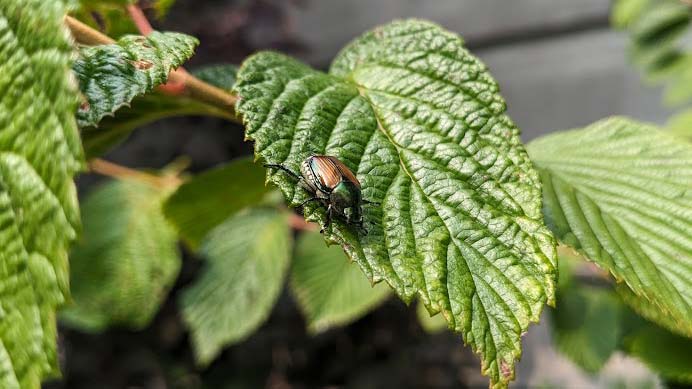Recent walks around many landscapes revealed an old pest that I had thought was diminishing. The numbers this year are certainly up and the damage the adults are inflicting is evident. Although these destructive pests do not inhabit the entire country, they are moving West. Here’s what you need to know about the Japanese beetle, Popillia japonica.
Adult Japanese beetles are not picky eaters—they are happy to dine on over 300 species of plant leaves. Their favorites can be used as indicator plants in the landscape. Grape, cherry, apple, rose, raspberry and linden are particularly favored. Of those, both the fruit-producing, and ornamental species are equally attacked.
They commonly will chew on leaves or even wholly consume the fruits and flowers. Their feeding habit on leaves is fairly unique and eye-catching. They will devour the fleshy material between the veins, leaving the veins themselves untouched and giving leaves a lacey look called skeletonization. Healthy plants will normally be able to withstand even heavy feeding with just some loss of aesthetics. Stressed, young or compromised plant material may not fare as well and potentially could be weakened to the point where environmental factors or another opportunistic invader will take them out.
History and Life Cycle
 For a bit of history, these insects are non-native and said to have been introduced to the U.S. in 1916 in New Jersey. Since then, they have progressively spread and migrated to most states westward.
For a bit of history, these insects are non-native and said to have been introduced to the U.S. in 1916 in New Jersey. Since then, they have progressively spread and migrated to most states westward.
Japanese beetles undergo a full metamorphosis, which means they start as an egg, hatch into a larva, then turn into a pupa and emerge as an adult. Three of these life stages are happening below the soil surface and each life cycle lasts about a year.
It is this understanding that makes their control slightly more simple. Adults emerge in mid-summer and can easily be seen on plants or flying around as they are large and bulky, measuring about 1/3 to 1/2 inches. Noticing adult flight should trigger the idea that they will be soon return to the soil to lay eggs. This bit of information is critical because young larvae are the easiest to control and doing so will greatly reduce the potential for turf damage.
Mated females lay eggs several times and can total up to 60. Eggs hatch in 10 to 14 days into larvae called grubs and begin feeding voraciously, mainly on turfgrass roots. Grubs molt three times, becoming larger with each instar. As the soil temperature cools, the third instar (largest) grubs burrow deeper into the soil for the cooler winter months. In the spring, large grubs return to the shallow soil level where minimal feeding will happen prior to the pupal stage, which is the last step before emerging as adult beetles.
Japanese beetles are considered some of the most destructive insects as they feed heavily during two life stages, as larvae on turf roots and as mentioned above as adults on ornamental leaves. The turf damage can often be confused with drought symptoms. Turf areas that have been affected by grubs will easily pull up or roll like carpet, again making the time to properly diagnose key to success.
During years of adequate moisture, feeding symptoms may be greatly reduced from a visibility standpoint as the turf is able to outgrow some of the feeding. Damage during drought or dryer conditions tends to be more severe along with sloped areas as the turf is unable to keep growing through the root loss. This also lends itself to vertebrate feeding. Skunks, armadillos and other animals will peel back turf looking for a tasty treat. Grubs will also feed on both cool season and warm season turf roots indiscriminately.
Methods of Control
Prior to the late 1990s, there were few options for preventative control and typically grubs were addressed following the detection of turf damage. Fortunately, most often this became visible in late summer to early fall so reseeding in that timeframe was fairly successful and damage could be masked, but the grubs were still present.
Historically, older chemistries such as Carbaryl (Sevin), Isofenphos (Oftanol), Trichlorfon (Dylox) and others have been used as curatives but this was only after damage was already apparent. These materials are strictly contact insecticides with very short residuals, meaning they didn’t last long, and several have been cancelled for certain applications or altogether by the EPA.
Later the introduction of Merit and Mach 2 revolutionized the approach to preventative grub management and would become the industry standards in terms of sub-surface feeding insect control. These products were very pricy in their infancy but exhibited outstanding preventative control. They had to be applied early and watered in to where the grub was feeding to be effective. Merit is the commercial name with the active ingredient imidacloprid and emerged as the leading choice for preventative grub strategies, It was soon followed by sister products in the neonicotinoid family including clothianidin (Aloft, Arena) and others. Of those, imidacloprid remains the workhorse for outstanding control with now economical pricing. In 2012, Mach 2 was canceled for use by the EPA, leaving the neonic class of chemistry alone in the market for several years. In many grub locales, combination products with imidacloprid applied to a granular fertilizer is available and has become the application method of choice.
There are some interesting observations that go along with Japanese beetle detection and habits. As mentioned, it seemed that populations had dipped greatly in many areas and maybe that was the case, much of course is based on the areas being controlled preventatively, but widespread damage seems to be down in many areas. That said, some have suspended annual treatment so there could be a population rebound and that seems to be what I am seeing. Also, larger groups can be localized.
Additionally, this insect tends to go through what is called invasion cycles. This means that initially when they are detected, numbers can stay low for a couple of years followed by population explosions. It is natural for areas to “wax and wane” in overall insect counts. Also interesting is the way plants actually attract adults. Damaged plant material give off an odor attracting more beetles, leading to the cluster like feeding often witnessed in heavy infestations.
Many contact insecticides are labeled for adult management, but one should apply carefully as to not treating flowers, which attract pollinators. Another approach is to select ornamentals that tend to not land on the insect’s menu, including boxwood, most conifers, euonymus, holly, lilac, magnolia, oak and others.
As always, read labels and apply pesticides safely.
Lean on Us for Help with Pests and Other Turf Issues
Ewing’s Turf Tech Team, myself and Pat Gross, are here to help you with pest control solutions and to answer any turf-care questions you have, so lean on us for expertise and product selection. Feel free to email me at klewis@ewingirrigation.com or call/text 480-669-8791 and email Pat at pgross@ewingirrigation.com or call/text 714-321-6101.




